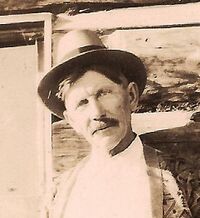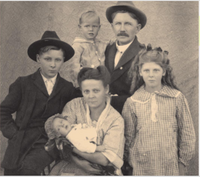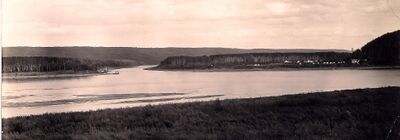Charles Eymundson: Difference between revisions
Pat Palmer (talk | contribs) mNo edit summary |
mNo edit summary |
||
| (3 intermediate revisions by one other user not shown) | |||
| Line 8: | Line 8: | ||
For additional details including a detailed bio, collections of Eymundson's photos, and a list of book he wrote, see Hermis<ref name=Hermis />. | For additional details including a detailed bio, collections of Eymundson's photos, and a list of book he wrote, see Hermis<ref name=Hermis />. | ||
Born in Sauðanes, Iceland, he worked a variety of careers. His father, formerly a sea captain, emigrated to the United States with his family in 1882. Eymundson's father died in 1886 while Eymundson was still a teenager. His mother brought the family near | Born in Sauðanes, Iceland, he worked a variety of careers. His father, formerly a sea captain, emigrated to the United States with his family in 1882. Eymundson's father died in 1886 while Eymundson was still a teenager. His mother brought the family near Red Deer, [[Alberta]]. Eymundson found work as a lumberjack, a private detective, and as a cook in China. He also became a skilled hunter, trapper, and wilderness guide. Eymundson's wife, Asdis Sophia Olafsson, was born in North Dakota to Icelandic parents.<ref name=hermisEymundson/> They married in 1910 and settled near Fort McMurray in Alberta. In 1918, a catastrophic flood hit their property, and they were stranded on their roof for two days. In the 1920s he served as a guide for Karl A. Clark, a geologist who played an early role in confirming the size and significance of the Alberta Tar Sands. | ||
In 1924 he took over the small telephone company that provided service in Fort McMurray and nearby waterways. | In 1924 he took over the small telephone company that provided service in Fort McMurray and nearby waterways. | ||
| Line 55: | Line 55: | ||
}} | }} | ||
[[Category:Reviewed Passed]] | [[Category:Reviewed Passed]][[Category:Suggestion Bot Tag]] | ||
Latest revision as of 06:00, 27 July 2024
Charles Eymundson (1872-1966) is best known as a photographer and author who recorded historic images of the early history of Canada's north and wrote three books about his travels.[1] His full name was Charles Matusalem Eymundson.
For additional details including a detailed bio, collections of Eymundson's photos, and a list of book he wrote, see Hermis[2].
Born in Sauðanes, Iceland, he worked a variety of careers. His father, formerly a sea captain, emigrated to the United States with his family in 1882. Eymundson's father died in 1886 while Eymundson was still a teenager. His mother brought the family near Red Deer, Alberta. Eymundson found work as a lumberjack, a private detective, and as a cook in China. He also became a skilled hunter, trapper, and wilderness guide. Eymundson's wife, Asdis Sophia Olafsson, was born in North Dakota to Icelandic parents.[1] They married in 1910 and settled near Fort McMurray in Alberta. In 1918, a catastrophic flood hit their property, and they were stranded on their roof for two days. In the 1920s he served as a guide for Karl A. Clark, a geologist who played an early role in confirming the size and significance of the Alberta Tar Sands. In 1924 he took over the small telephone company that provided service in Fort McMurray and nearby waterways.
Provenance
- Some content on this page may previously have appeared on Wikipedia.
References
- ↑ 1.0 1.1 Fonds PR3659 - Charles Eymundson fonds, Provincial Archives of Alberta. Retrieved on 2020-12-11.
- ↑ Charles Matusalem Eymundson in HeRMIS, Heritage Resources Management Information System, Provincial Archive of Alberta, Canada


